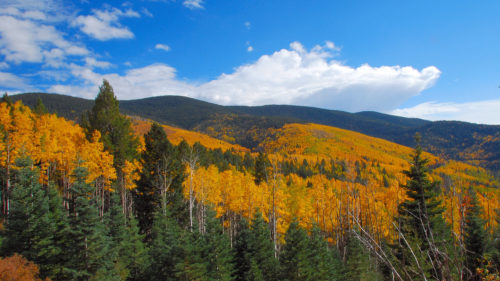At the October 2016 meeting of the New Mexico Department of Game and Fish commission, Mike Phillips from the Turner Endangered Species Foundation discussed Mexican wolf recovery at length. One part of his update that stuck out in my mind was his mention of the lack of public lands in Mexico. It highlighted how fortunate Americans are to have such large tracts of public land to aid our wildlife – and enjoy ourselves – and how intricately our wildlife management is tied to our neighbors to the south. Whether you agree with the reintroduction of wolves or not, it is impossible for their recovery to happen without the aid and cooperation of our counterparts in Mexico. By blocking off Mexico with the construction of a proposed wall, their recovery and the recovery of many other species, is on the line.
Wolves are not the only animal that depend on large sections of public lands to thrive. The wall would bisect the critical juncture where the southern end of the Rockies connects with the northern tip of the Sierra Madres, flanked by the Sonoran and Chihuahuan deserts. This is the most ecologically diverse region in North America. Desert bighorns, Coues and mule deer, Sonoran antelope, black bears, jaguar, and myriad non-game species rely on the critical cross – border habitats for their very survival.
Healthy wildlife populations – and especially desert creatures – depend on large, intact landscapes to migrate and maintain healthy numbers. Habitat loss and fragmentation thanks to human activity are widely considered to be one of the main causes for biodiversity loss and ecosystem degradation across the globe1. Things like fences and highways can cause serious disruption for migrating animals. These barriers can split up populations leading to a diminished gene pool, which can seriously harm the health of animal populations.
One example of this in the Southwest is the corpuscular ocelot. Only about 50 ocelots remain in the United States, and many of them are found in the Rio Grande Valley of Texas. Fences along the Texas border have cut US ocelots off from other populations in Mexico, leaving them with a weakened genetic pool2. Ocelots are not the only animal that would be impacted by the construction of a border wall, bobcat, deer, javelina, Texas tortoise, and the indigo snake are just some of the animals that would be impacted by not having access to wildlife corridors.
Desert bighorn sheep and Sonoran Antelope would be heavily impacted by the construction of the wall as well. A study3 by Oregon State University estimated that at least nine populations of desert bighorn sheep living in Sonora, Mexico are genetically connected to desert bighorn sheep in Arizona – blocking these migrations could severely damage the populations in the United States and Mexico. As we’ve seen time and time again, isolating these migrating animals could deplete their genetic diversity and cause serious health concerns.
Cutting these animals off now and reducing their genetic diversity would be especially troublesome given what a conservation success story they are. In 1980, desert bighorn sheep in New Mexico were listed as an endangered species. Thanks to the Endangered Species Act and an aggressive conservation program they were downlisted from endangered to threatened in 2008. In fact, their numbers are doing so well, hunters across New Mexico can now apply for desert bighorn sheep hunts in the southern part of the state.
“Isolating populations not only reduces genetic diversity it makes the animals more susceptible to disease, drought and other weather extremes, and predation. We’ve seen one or two mountain lions knock down populations of sheep once they get a taste for mutton,” said Clinton Epps, a wildlife biologist at Oregon State University.
In fact, fences along the border are already impacting4 pronghorn antelope along the Arizona/Mexico border. Biologists from the Arizona Game and Fish Department noticed a decline in population three years ago. Certain herds lost population at such an alarming rate that they became unsustainable.
In addition to the actual wall blocking animals, the construction of the wall will degrade and fragment an estimated 500 acres of land, wildlife habitat encompasses almost all of that acreage5. Construction alone will cause stress to wildlife populations in an already vulnerable area. Last year, the United States Fish and Wildlife Service conducted a study6 that found that the wall could impact 111 threatened or endangered species from Texas to California.
Land animals would not be the only wildlife impacted, migrating birds could also feel the effects of the wall. Part of the proposal calls for “high intensity artificial lighting” on many miles of the border – this could have a serious negative impact on migrating birds which get confused by the light and can collide into manmade structures or other birds. These collisions are often fatal. Although not widely studied, artificial lighting can also change animal behavior.
In addition to these very tangible impacts, the wall would severely disrupt Big Bend National Park in Texas. Some of the most wild and remote portions of the park would be damaged by the construction of the wall, changing it forever (NWF). The wall would also go through four national wildlife refuges, and set back innovative private land conservation efforts at the Malpais Borderlands here in New Mexico.
The United States has the right to protect it’s borders, but is this wall, that will cause irreparable harm to our wildlife and our culture as New Mexicans the correct way to go about it? Given the enormous cost – both financially and to our wildlife and way of life – the only answer the New Mexico Wildlife Federation can come up with is “no.”
Citations:
- Wilson, M.C., Chen, XY., Corlett, R.T. et al. Landscape Ecol (2016) 31: 219. doi:10.1007/s10980-015-0312-3
- Stein, Bruce. National Wildlife Federation (January 31, 2017). http://blog.nwf.org/2017/01/trumps-wall-erecting-new-barriers-to-recovering-americas-wildlife/
- Oregon State University, 2009. http://oregonstate.edu/ua/ncs/archives/2009/jul/us-mexico-border-wall-could-threaten-wildlife-species-biologists-warn
- Ortega, Bob. Environmentalists: Border fence putting Arizona pronghorns in peril. The Arizona Republic, January 24, 2013. http://archive.azcentral.com/news/articles/20130111arizona-pronghorns-environmentalists-border-fence-peril.html
- Eriksson, Lindsay, Taylor, Melinda. The Environmental Impacts of the Border Wall Between Texas and Mexico. University of Texas Law School.
- USFWS, 2016. http://www.veritasresearchconsulting.com/USFWS/USFWS-Trust_Resources-TrumpWall.pdf
This article appeared in the Spring 2017 edition of the Outdoor Reporter.



